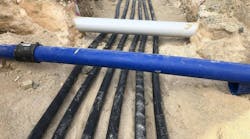Beyond reliability, a focus on convenience and citizenship separates top-performing electric utilities from competitors regarding business customer satisfaction. That's the central finding of the J.D. Power 2018 Electric Utility Business Customer Satisfaction Study, which recognizes regional electric utilities that are setting the standard for the most satisfying customer experience.
"While the top-performing electric utilities have developed a strong formula for business customer satisfaction, performance can vary considerably from one provider to the next," said Adrian Chung, director, Utilities Practice at J.D. Power. "The highest-ranking electric utilities make it easier to do business with them by offering customers online account management tools and products that drive cost savings. This service execution, along with a strong commitment to supporting local communities, plays a critical role in gaining satisfaction and building customer trust."
Following are some key findings of the 2018 study:
- Digital presence for account management improves satisfaction: Customers have higher satisfaction when they have an online account and choose to receive an electronic bill. On average, offering these options leads to a 47-point increase (on a 1,000-point scale) in overall satisfaction. Customers of award-recipient utilities are 7 percentage points more likely to receive monthly statements electronically and 6 percentage points more likely to access their accounts online when compared with customers of other utilities.
- Community presence is a differentiator: Among the highest-ranking utilities, 75% of customers say their utility supports the economic development of the local community, which is 7 percentage points higher than for non-recipient utilities.
- A similar gap exists in customer awareness of utility employees volunteering in the community.
- Utilities can support business customers with product and service offerings: Electric utilities that proactively communicate outage information, product offerings and other utility messages enjoy customer satisfaction scores that are 50 points higher than those that do not provide proactive communications. Overall, satisfaction is 11 points lower among customers who need to contact their utility to get information than among those who receive proactive communications.
- It pays to be proactive: Customers of the highest-ranking utilities are more likely to be aware of peak-time savings programs and real-time energy monitoring tools, both of which stand to offer sizable cost benefits.
- Dedicated account representatives positioned to build strong relationships: Businesses with an assigned key account representative receive significantly higher image ratings of being "customer-focused" and "trustworthy" compared with businesses that typically contact their utility through a business-specific services center or a general utility customer service telephone number.
Within each of the four geographic regions included in the study, utility providers are classified into one of two segments: large (serving 85,000 or more business customers) and midsize (serving 40,000-84,999 business customers).
The following utilities rank highest in business customer satisfaction in their respective regions:
- East Large: BGE
- East Midsize: Duquesne Light
- Midwest Large: MidAmerican Energy
- Midwest Midsize: Indianapolis Power & Light
- South Large: Georgia Power
- South Midsize: Entergy Texas
- West Large: SRP
- West Midsize: SMUD
All regional rank charts can be seen at http://www.jdpower.com/pr-id/2018229.
The 2018 Electric Utility Business Customer Satisfaction Study, now in its 20th year, measures satisfaction among business customers of 88 targeted U.S. electric utilities, each of which serves more than 40,000 business customers. In aggregate, these utilities provide electricity to more than 12 million customers. Overall satisfaction is examined across six factors (listed in order of importance): power quality and reliability; corporate citizenship; price; billing and payment; communications; and customer service.
The study is based on responses from more 19,000 online interviews with business customers who spend at least $200 a month on electricity. The study was fielded from February through June 2018 and July through October 2018.


